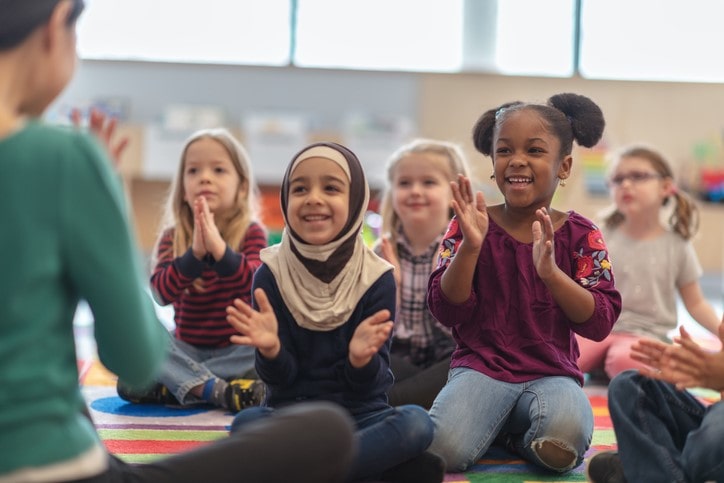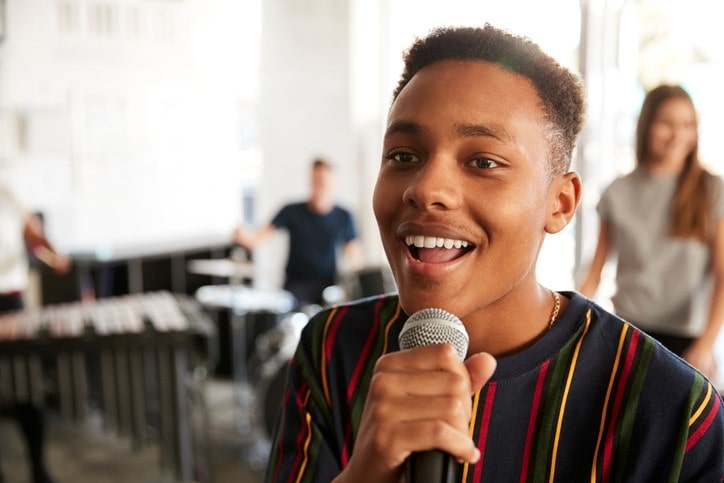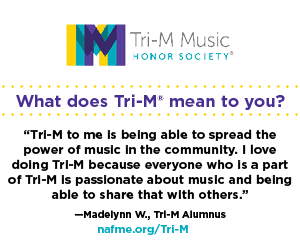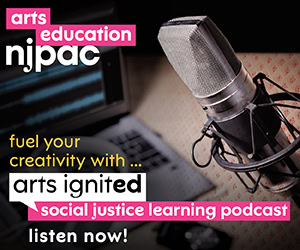/ News Posts / Guiding Principles for Improvisation in the General Music Classroom
A Way of Being in Music
Guiding Principles for Improvisation in the General Music Classroom
By NAfME Member David C. Edmund and Elliott C. Keller
General Music Today, First published via Online First on November 1, 2019
Abstract: Improvisation is a fundamental aspect of musicianship and an important pursuit in music education. Children in music classes throughout the world are engaged with improvisation in a variety of modes and settings. Whether singing, physically moving, or playing an instrument, the act of improvising in front of others may raise one’s self-consciousness, potentially leading to feelings of fear and anxiety. We wish to share guiding principles for improvisation to alleviate many of the associated fears. The establishment of a classroom improvisation culture may breed willful participation and acceptance. When willful participation and acceptance become habitual, the goal of establishing a safe space for students to explore their musical creativity is more readily achieved. A manifestation of the guiding principles is shared in the form of two model improvisation experiences for the general music classroom.
The act of musical improvisation can be scary. Riveire (2006) suggests the importance of considering and alleviating “your students’ and your own anxiety about improvisation” (p. 43). When improvising, we expose our creative musical being and place our self in a vulnerable position. Who is listening to us? Are they judging us? Are our peers assessing us? Our mentors? Our students? There can be immense pressure to make a good musical impression. Improvising is scary. It can be challenging and intimidating. As educators, we have to acknowledge this fear for ourselves and realize that our students experience similar feelings. First, we can understand that the fear of improvisation is a shared human experience. Next, we may learn that fears associated with improvising may be overcome. As teachers, we can make our classrooms a safe space to create, experiment, fail, and then ultimately succeed. Guiding principles for improvisation can help to establish a clearer path for both students and teachers, as well as develop a culture of improvisation in our classrooms.
A study of relevant research points to five principles to use when planning for fear-less improvisation activities in the general music classroom:
-
- Experience first, before intellectualizing.
- Improvise within structure/syntax.
- Perform by ear.
- Improvisation is a way of being in music.
- Balance freedom with structure.
In addition, we share model experiences for improvisation intended for primary and intermediate ages with the hope that our readers may generate their own original ideas for teaching and learning improvisation.
Experience Before Intellectualization
A tenet of the Orff approach is that musicians experience their sonic environments through performing, creating, and responding before deriving meaning from those sounds (Campbell, Scott-Kassner, 2019; Frazee, 1987; Scott, 2008). Frazee (2014) refers to “making, making up, and making sense of musical material” (para. 2). Making sense notably follows the experiences of making and making up music. This principle applies to a variety of musical situations, whether generative or imitative, from early childhood through adulthood. Children naturally tend to this principle when embellishing their own arrangements of simple songs or creating their own. Young instrumentalists (e.g., when warming up before band rehearsal) subtly alter the rhythms and/or melodies they are fond of from their ensemble repertoire. General music teachers guide their students in creative musical response through movement. In each case, it is the experience that leads to deeper musical understanding. When we insist upon “instructing” before doing, we put the proverbial cart before the horse. It is doubtful that the child consciously employs blue note alterations to a pentatonic melody. In such cases, they are likely considering the sounds they create, as opposed to the technical or literacy-based aspects. Likewise, young instrumentalists probably do not mentally transcribe their own rhythmic embellishments. Rather, it is the spirit of exploration that opens the door to musical curiosity, spontaneity, and freedom.
Encouraging a student’s musical curiosity is one way to avoid the fear involved with improvising. First, we make it acceptable to perform new and original music. Second, we avoid overwhelming young improvisers with too many musical facts and guidelines. Freeing the improviser’s mind from potential cognitive overload helps her to focus upon the musical task itself and avoid the fear of performing music in “correct” ways.
Improvisation experiences might begin with listening, responding, moving, drumming, or clapping. The model experiences shared below begin with listening, imitating, chanting, and responding through movement before singing a melody or improvising. Campbell and Scott-Kassner (2019) suggest that improvisation processes originate with imitation before proceeding with rhythmic exploration, creative movement, and literacy. While the movements allow a certain freedom, there are purposeful structures found within the music. Those structures include rhythmic selection, phrase length, harmonic progression, and melodic organization.
Improvise within Structure/Syntax
Improvisation often functions as an exercise in creative exploration. With too many constraints, the improviser is limited and less able to explore. With too little structure, the improviser may become lost, unable to conceive of a place in which to begin. Improvising within musical structure offers a guiding pathway for the implementation of choice. Scholars (Beegle, 2010; Gruenhagen & Whitcomb, 2014; Snell & Azzara, 2015) suggest that the incorporation of specific guidelines for student improvisational activities provides security. Edmund and Chen-Edmund (2016) note the importance of sequence, connected instruction, and “structured approaches for learning improvisation” (p. 526).
There are many diverse and varied approaches for the provision of improvisational structure, ranging from the performance of one-note improvisation to a completely free approach, devoid of guidelines. Improvisational structure operates along a continuum from simplicity to complexity, leading to what Beegle (2010) refers to as “freedom of musical expression” (p. 224). Setting our students up for success is dependent upon establishing a balance between structure and musical freedom, inspiring students while providing a foundation for creative musical growth.
Musical syntax1 creates a common language for musical improvisation. Common rhythmic, melodic, and harmonic structures offer the improviser aural and notation-based guidelines. The addition of structure adds a layer of security for the musician who seeks to explore rhythmic, harmonic, and melodic devices spontaneously.
Established syntax may also help the musician to improvise in a specific style. Imitation is a tried and true method for sharing stylistic guidelines for improvisation in jazz (Berliner, 1994) and other styles. Furthermore, young musicians learn to improvise within syntax by imitating peers, teachers, or other musical models. Imitation offers students an aural model of what improvisation can sound like before applying musical devices in their performance
Perform by Ear
Famed jazz saxophonist Charlie Parker was noted for saying, “Master your instrument, master the music, and then forget all that [sic] stuff and just play” (Jazz quotes, n.d.). The latter portion of Parker’s statement refers to instinctive musical execution. Instincts, in this case, link aural understanding (i.e., performing by ear) with musical interpretation and an application of theoretical material (Berliner, 1994).
One’s ability to sing and play by ear without the use of a written score directly affects their ability to improvise. Improvisation calls for the performer to spontaneously reproduce what their mind suggests, whether consciously or in the subconscious. Improvisers often adhere to codes or patterns (see “structure” above), but some use a more free and flexible approach. In either case, the improviser attempts to deliver the material that the mind produces. Audiation of that material is necessary in order to accurately produce intended musical sounds.
Performing by ear is beneficial not only for improvisational ability but also for musicianship in general. Woody (2012) claims, “In music, it is the ear that defines great musicianship” (p. 82). Berliner (1994) states, “Artists aural understanding and appreciation of music guide interpretation of theoretical material and drive its applications” (p. 168).
While some may consider performing by ear to be independent from musical literacy, Snell and Azzara (2015) explain that improvising and performing by ear contribute to musical literacy. This notion relates back to the concept of audiation. Vocalists and instrumentalists rely upon numerous skills (cognitive, musical/technical, expressive, etc.) when interpreting written music. Processing the written cues aurally assists with accurate execution of musical passages. It also lightens the cognitive load, allowing the performer to focus on their expressive interpretation. A similar phenomenon occurs when improvising. The improviser’s aural understanding of the sounds they produce assists with pitch/rhythmic accuracy, but it also enables them to focus on playing musically. It will take time for some improvisers to become comfortable performing by ear, while others will find the lack of a written score to be freeing. We suggest that with experience over time, all improvisers may overcome any fears of performing by ear and improvising.
Improvisation Is a Way of Being in Music
This is possibly the most holistic and abstract of the guiding principles for musical improvisation. Process and experience play important roles in our ways of musical being. Higgins and Mantie (2013) explain that improvisation embodies “risk-taking, reflexivity, spontaneity, exploration, participation, and play” (p. 39). Each of these embodiments involves musical ways of being. Improvisers frequently take risks. Musical improvisation is spontaneous and requires the musician to act reflexively, according to their thoughts and any accompanying musical sounds. Improvisational experiences should involve exploration of rhythmic, melodic, and harmonic material. Classroom improvisation should also be participatory and playful in nature. Frazee (2014) cites the importance of exploration, reminding us that “when students teach themselves through improvising, they are given personal agency” (para. 3).
The musical practices suggested above constitute commonplace encounters in general music classrooms. Every teacher’s goal is to develop students’ inclination to take risks, to reflect on outcomes, and to participate in all proffered activities. Improvisation provides the perfect musical vehicle through which our students can engage with these practices. When these practices become commonplace for the teacher and student alike, an atmosphere is created in which improvisation is a way of being. Easier said than done, right? Well, yes and no. For some, being musical through improvisation will present unique challenges and for others it will come quite naturally. One goal should be for music educators to assist the process of making improvisation a comfortable musical act.
We believe that by adhering to these guiding principles, the act of musical improvisation may become increasingly comfortable, even for those who fear it most. Recently, one of the authors observed a preservice music teacher who was leading an improvisation activity in a high school jazz ensemble. Each member of the ensemble took turns at improvising over a blues. In between, students were guided in brief moments of reflection, where they described thought processes and what they liked most about their solos. In this classroom, improvisation was clearly a way of being for the preservice teacher and students. A level of comfort was achieved through process, repetition, and the mutual sharing of ideas.
Our research and experience with improvisation resulted in the previous four guiding principles. The list was not intended to be exhaustive but rather meant to provide key considerations for approaching the teaching of improvisation in general music classrooms and overcoming associated fear factors. Upon reflection during the preparation of this article, we determined that a fifth principle was necessary. While the importance of structure is a primary theme, we found it necessary to add the following guiding principle.
Balance Freedom with Structure
Beegle (2010) suggests, “Finding a balance between freedom of choice and useful constraint is key to inspiring and maintaining children’s musical creative growth” (p. 235). While the use of structure, what some refer to as “constraints,” is enabling for some, others thrive upon their sense of musical freedom. Choice is the essence of improvisation and our goal as educators should be to engage and enable our students to generate their own spontaneous rhythms, melodies, accompaniments, and expressive devices. Guiding and modeling the choice-making task may involve an introduction of specific musical devices. There is special value, however, when children discover their own preferred collection and arrangement of pitches, rhythms, and so on.
The following presentation of model experiences is intended to illustrate the guiding principles in musical ways. Please note that these are only two examples. We encourage the reader to use this information as a framework through which you might develop your own improvisation experiences according to your and your students’ needs. Application of the principles is not strictly sequential. Some of the steps may occur through a different sequence, depending upon the nature of the music being performed. Furthermore, some of the principles are applied in multiple ways. The following compositions are intended for use in elementary general music classes. They have been implemented in college-level methods courses and shared in elementary music classrooms.
Primary-Level Model Improvisation Experience
The purpose of this composition (Figure 1) is to develop rhythmic improvisation skills for primary-aged children. Improvisations may be chanted, performed through body percussion, or using rhythmic instruments.
The teacher may begin by sharing the chant or, with more advanced groups, by leading the children in performing beats two and four, by patting or playing an instrument. Once the chant is learned, the teacher may share single-measure phrases, with the children echoing. Phrases may then be doubled in length. The selection may involve individual and/or group improvisation. Children might be divided into groups of two and share their own improvised rhythms, while their partner echoes. Teachers are encouraged to alter any aspects of the selection, to best meet the needs of their students.
Intermediate-Level Model Improvisation Experience
This simple pentatonic melody (Figure 2) provides musical context for improvisation in upper elementary grades. The melody may be sung or played on a variety of instruments, including soprano recorder.
In order to scaffold the improvisation experience, a “doorway in” is provided in the form of a recorded rendition of the piece.2 The audio file is a GarageBandTM production, consisting of an introduction, melodic performance, improvised solo, and conclusion. The purpose of the audio file is to introduce the melody and provide a sound source for imitative and creative movement. The movement activity engages its listeners, while encouraging spontaneous kinesthetic response.
Each model experience allows participants to experience music before processing any technical aspects of rhythm, melody, or harmony. It offers a basic structure or musical syntax in its use of pentatonic melody over a three-chord progression. Participants learn to sing or play the melody initially by ear and then engage with instrumental or vocal improvisation. Table 1 illustrates some of the ways these guiding principles are embodied through each model experience.
The purpose of this article is to share a concise list of guiding principles to facilitate the teaching and learning of improvisation in general music classrooms. More specifically, we seek to help students and teachers to overcome some of the fear factors associated with improvisation. These principles are intended to be not prescriptive but rather interpretive. Guiding children’s musically generative experiences, challenging them to learn and perform by ear, providing structure through which children can improvise, and balancing freedom with structure will help to build a culture of improvisation, making it a way of being in music.
Notes
1. See the step progression in Figure 1 for an example of musical syntax.
2. Visit www.dcedmund.com to hear the audio recording.
References
Beegle, A. C. (2010). A classroom-based study of small-group planned improvisation with fifth-grade children. Journal of Research in Music Education, 58, 219–239.
Berliner, P. (1994). Thinking in jazz: The infinite art of improvisation. Chicago, IL: University of Chicago Press.
Campbell, P. S., & Scott-Kassner, C. (2019). Music in childhood: From preschool through the elementary grades (Enhanced 4th ed.). Boston, MA: Cengage Learning.
Edmund, D., & Chen-Edmund, J. (2016). Modular assessment of creativity in general music. In T. S. Brophy, J. Marlatt, & G. K. Ritcher (Eds.), Connecting practice, measurement, and evaluation (pp. 525–537). Chicago, IL: GIA.
Frazee, J. (1987). Discovering Orff: A curriculum for music teachers. New York, NY: Schott Music Corporation.
Frazee, J. (2014, November). Improvisation and Orff Schulwerk. Post shared at the Meeting of the Minds panel discussion on the topic of improvisation at the 2014 AOSA Professional Development Conference, Nashville, TN. Retrieved from https://aosa.org/experts-blog/improvisation-orff-schulwerk/
Gruenhagen, L. M., & Whitcomb, R. (2014). Improvisation practices in elementary general classroom. Journal of Research in Music Education, 61, 379–395.
Higgins, L., & Mantie, R. (2013). Improvisation as ability, culture, and experience. Music Educators Journal, 100(2), 38-44.
Jazz quotes. (n.d.). Charlie Parker. Retrieved from http://jazz-quotes.com/artist/charlie-parker/
Riveire, J. (2006). Using improvisation as a teaching strategy. Music Educators Journal, 92(3), 40–45.
Scott, S. (2008). Kodaly? Orff? Early years music methods. Retrieved from http://carrieelliott.weebly.com/uploads/3/0/3/4/3034331/kodaly_and_orff_comparison.pdf
Snell, A. H., & Azzara, C. D. (2015). Collegiate musicians learning to improvise. Bulletin of the Council for Research in Music Education, 204, 63–84.
Woody, R. H. (2012). Playing by ear: Foundation or frill? Music Educators Journal, 99(2), 82–88.
DOI: 10.1177/1048371319885361
About the authors:
 David C. Edmund is an associate professor of music education at the University of Minnesota Duluth, where he teaches undergraduate and graduate courses in elementary methods, adaptive music, and psychology of music. His teaching and research interests include improvisation pedagogy, music teacher artistry, and musical creativity for students with exceptionalities.
David C. Edmund is an associate professor of music education at the University of Minnesota Duluth, where he teaches undergraduate and graduate courses in elementary methods, adaptive music, and psychology of music. His teaching and research interests include improvisation pedagogy, music teacher artistry, and musical creativity for students with exceptionalities.
Elliott C. Keller is a recent graduate in music education from the University of Minnesota Duluth and will be joining the U.S. Marine Corps as a saxophone performer in Fall 2019.
Did this blog spur new ideas for your music program? Share them on Amplify! Interested in reprinting this article? Please review the reprint guidelines.
The National Association for Music Education (NAfME) provides a number of forums for the sharing of information and opinion, including blogs and postings on our website, articles and columns in our magazines and journals, and postings to our Amplify member portal. Unless specifically noted, the views expressed in these media do not necessarily represent the policy or views of the Association, its officers, or its employees.
Catherina Hurlburt, Marketing Communications Manager. December 20, 2019. © National Association for Music Education (NAfME.org)
Published Date
December 20, 2019
Category
- Culturally Relevant Teaching
- Repertoire
- Research in Music Education
Copyright
December 20, 2019. © National Association for Music Education (NAfME.org)









